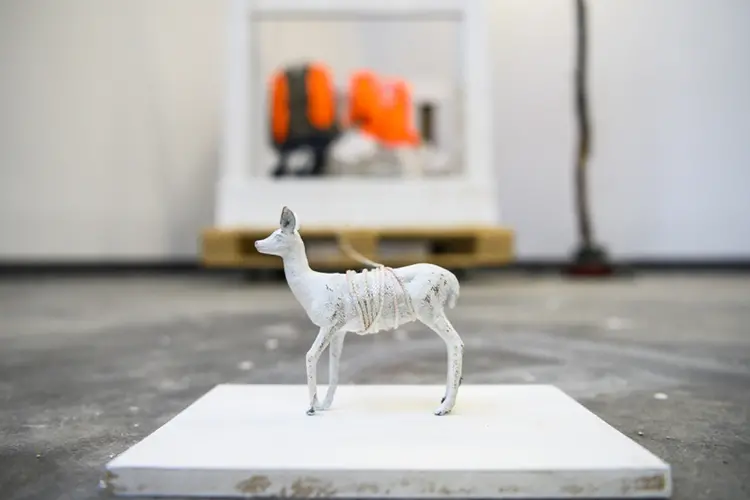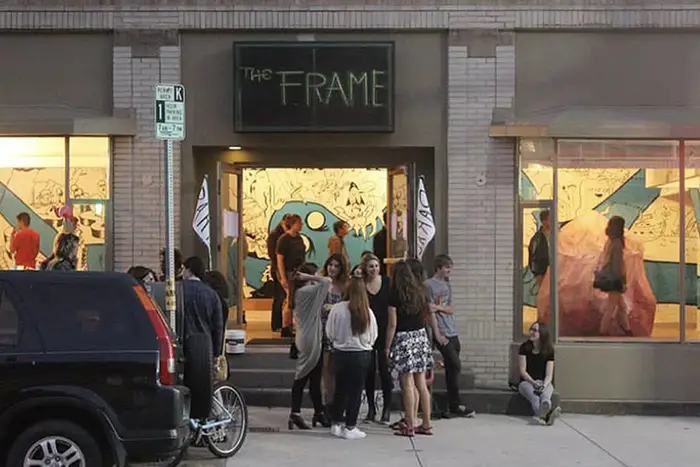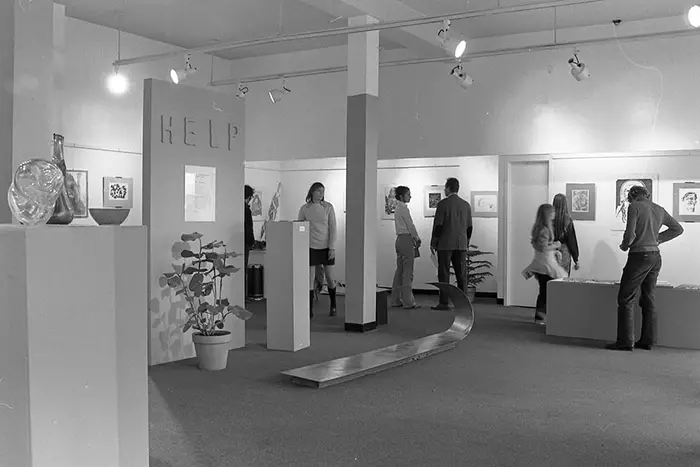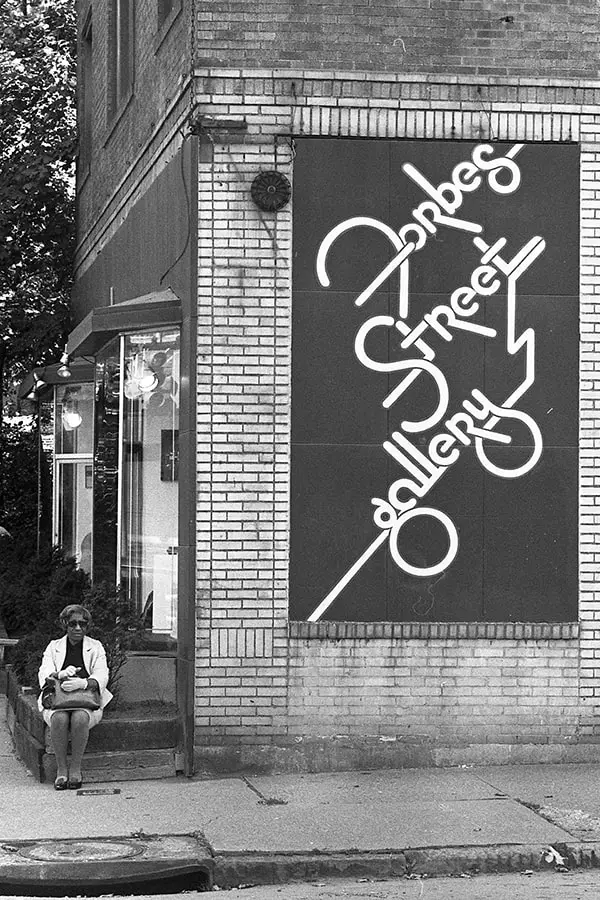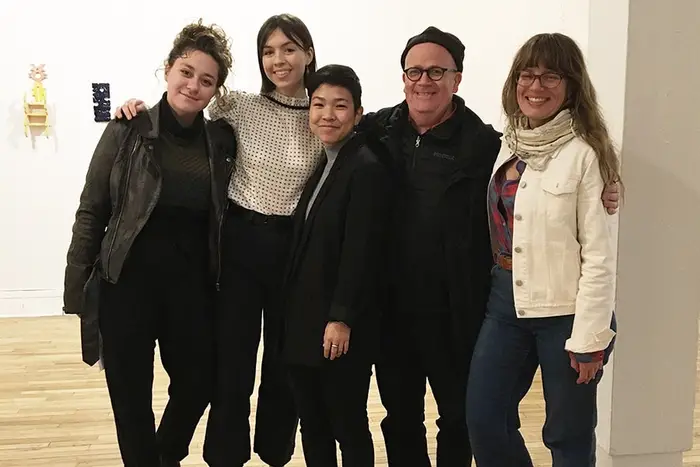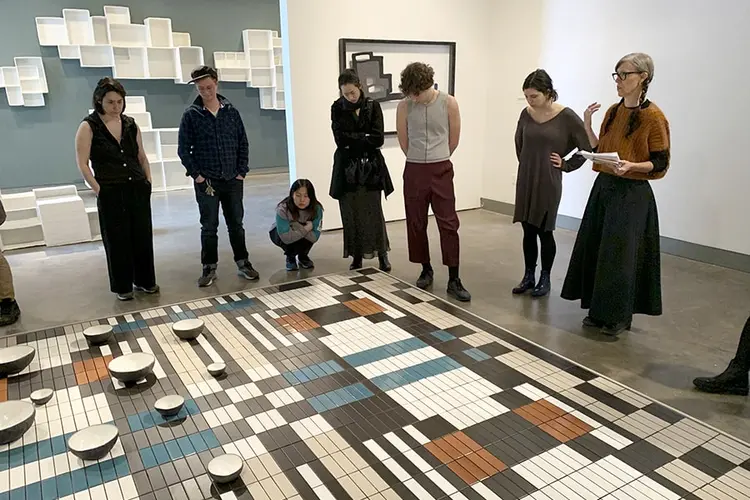The Frame Gallery Enters New Era with Major Renovation
Media Inquiries
The Frame Gallery, Carnegie Mellon University's student-run art gallery, will undergo a major renovation this summer to make the venue accessible to all audiences and provide critical upgrades. Since its founding in 1969, The Frame has served as a crucial public-facing venue for free expression, diverse perspectives and inclusive community. This $275,000 renovation ensures The Frame will continue to be an important locus of creative expression for CMU and the greater Pittsburgh community for generations to come.
To make the space compliant with the Americans with Disabilities Act, a new restroom will be constructed on the ground level and the entrance will be modified to include a ramp. Further improvements will ensure that a wide variety of exhibitions and events can be held at The Frame, including: replacing the existing wallboard with double-layered plywood and a drywall finish so that art may be safely hung on the walls; replacing the lighting with easy-to-configure and energy-efficient LED fixtures; and general maintenance of the space such as floor refinishing, new paint and new baseboards. The renovation also includes a complete rehab of the fa�ade and the installation of new signage.
A recent exhibit at The Frame Gallery.�
The CMU Students' Gallery in 1974.
The renovation of The Frame stems from the advocacy of student leaders and includes support from across the university. Funding is provided by the�Office of the Provost(opens in new window), Division of Student Affairs(opens in new window), CMU Housing Services(opens in new window), the CMU Universal Access Committee, Student Government(opens in new window), the College of Fine Arts(opens in new window) and the School of Art(opens in new window). The work is slated to begin in May and finish in time for the fall 2023 semester.
"Carnegie Mellon is thrilled to invest in the remarkable legacy and promising future of The Frame Gallery," said Provost James H. Garrett Jr(opens in new window). "For more than 50 years, The Frame has hosted hundreds of exhibitions, performances and events. Its scope reaches beyond the College of Fine Arts and presents opportunities for interdisciplinary collaborations across Carnegie Mellon and in our community. This renovation ensures the longevity of this important asset for our community."
The Storied History of The Frame
The effort to establish a student-run gallery on campus was led by A. Aladar Marberger, who would go on to be an influential gallerist and outspoken gay rights and AIDS activist. With the 1969 termination of the Woodlawn Pharmacy lease, located at the corner of Margaret Morrison Street and Forbes Avenue, Marberger, along with fellow CMU students Don Whipple and Stuart White, petitioned the university to support the establishment of a gallery. According to an article in The Pittsburgh Press (Oct. 30, 1969), Marberger led the effort to garner university support by "bothering the people in the office of the president until, impressed, they came up with an emergency budget to get the remodeling started."
The Carnegie Alumni News (February 1972) noted that the university allocated $10,000 to retrofit the space as a gallery. The university also had to obtain a commercial zoning variance "against neighborhood opposition that the gallery would become a 'hippie hangout.'" The Pittsburgh Press article notes that Dean of Student Affairs Earl Swank eased the fears of the opposition by assuring the community that "he would keep an eye on the operation from his apartment on the second floor of the building." The Carnegie-Mellon Students' Gallery (pictured above in 1972), or Student Gallery as it was more frequently known, opened on Oct. 28, 1969, with over 1,500 people in attendance.
The gallery became known as Forbes Street Gallery (pictured at left in 1976) by 1974 and Forbes Gallery by 1982 before finally being renamed The Frame (or The Frame Gallery) by 1997.
"From its founding, The Frame has demonstrated that at Carnegie Mellon, students can accomplish the extraordinary," said Gina Casalegno(opens in new window), vice president for Student Affairs and dean of students. "The Frame is a unique showcase for our students' drive and passion as they uncover new forms of knowledge and expression through collaboration and creativity. The work of students to maintain this undergraduate-led space over generations is an impressive feat."
After he graduated from CMU, Marberger was encouraged to move to New York by Elaine de Kooning, who was a visiting professor at CMU from 1969-70. In the 1970s, he became the first director of Fischbach Gallery; under his direction, the gallery became a leader in presenting contemporary realism.
Marberger was the longtime partner of Robert Joffrey, the influential dancer, teacher, producer, choreographer and co-founder of the Joffrey Ballet. When Marberger was diagnosed with AIDS in 1985, he became outspoken about living with the disease and was the subject of numerous newspaper and magazine articles as well as a television documentary. He was also an early volunteer for experimental treatments. He died of AIDS-related complications in 1988, just eight months after Joffrey.
Ensuring the Legacy of The Frame for Future Generations
The effort to update The Frame began under Anne Crumley, a 2019 CFA graduate, who served as the director of the space during the 2018-19 academic year. By that time, the gallery needed repairs: the wallboard had become damaged, the lighting was inadequate and the general conditions in the space had deteriorated. Crumley worked with the next cohort of leaders, Coco Allred and Zachary Rapaport, who both graduated from CFA in 2020, to further advocate for updates.
"Stopping by The Frame on Friday evening was a ritual to gather, discuss and celebrate the creative output of our arts community and share with the university at large," noted Allred. "Directing The Frame, I learned so much about what it takes to run a gallery, advocate for the arts and support artists." After graduation, Allred organized community art events and completed an ArtistYear, an AmeriCorps program that places teaching artists in schools. She's currently at an artist residency in Italy.
From left, Miranda Miller, Coco Allred, Ema Furusho, Professor John Carson, and Jenn Gooch at The Frame Gallery in 2019. Photo Courtesy of Coco Allred
In 2020, the student government vice president for finance, via the Joint Funding Committee(opens in new window), allocated The Frame $40,000 to update the space. Updates began under the next cohort of leaders, Iz Horgan and Moxie Duncan-Tessmer, both 2021 CFA graduates, who, despite pandemic restrictions, began the process of renovating the gallery.
"I always loved that The Frame itself was a mystery to pedestrians," said Horgan. "The gallery disguises itself as a storefront, with large, display-like windows. One day if you walk past, it might be empty and the next day it might be completely transformed, almost overflowing with artwork. I am proud of the many hours of hard work and negotiation my team members, along with the cohort before us, dedicated to The Frame Gallery." Since graduating, Horgan continues to be a working artist.
Once renovations began, it became apparent that The Frame needed more than cosmetic repairs. With this understanding, the School of Art worked with student leaders to advocate for a full renovation of The Frame to restore its prominent role on campus.
Bridging the Past with the Future
The Frame provides a space for the CMU and Pittsburgh communities to experience the creativity of students, offering a welcoming and inclusive venue for the free exchange of ideas and learning.
"I am honored to play a small part in the impressive legacy of The Frame Gallery by supporting this essential renovation," said Charlie White(opens in new window), head of the School of Art. "From the vision and tenacity of Aladar Marberger in carving out an entirely student-run campus space to the scores of student-artists who have exhibited in the space since its founding, The Frame has played a unique role in fostering generations of creative thinkers and cultural leaders at CMU."
— Related Content —

Stroll Through CMU's History Via Art Displays
